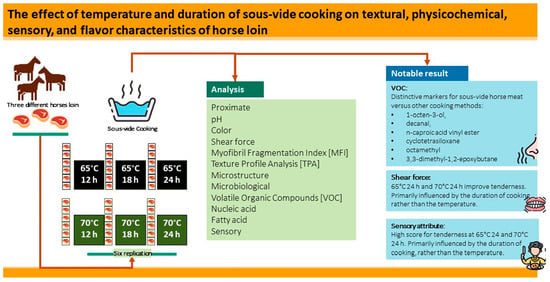Physicochemical Features and Volatile Organic Compounds of Horse Loin Subjected to Sous-Vide Cooking
Abstract
Share and Cite
Sujiwo, J.; Lee, S.; Kim, D.; Lee, H.-J.; Oh, S.; Jung, Y.; Jang, A. Physicochemical Features and Volatile Organic Compounds of Horse Loin Subjected to Sous-Vide Cooking. Foods 2024, 13, 280. https://doi.org/10.3390/foods13020280
Sujiwo J, Lee S, Kim D, Lee H-J, Oh S, Jung Y, Jang A. Physicochemical Features and Volatile Organic Compounds of Horse Loin Subjected to Sous-Vide Cooking. Foods. 2024; 13(2):280. https://doi.org/10.3390/foods13020280
Chicago/Turabian StyleSujiwo, Joko, Sangrok Lee, Dongwook Kim, Hee-Jeong Lee, Soomin Oh, Yousung Jung, and Aera Jang. 2024. "Physicochemical Features and Volatile Organic Compounds of Horse Loin Subjected to Sous-Vide Cooking" Foods 13, no. 2: 280. https://doi.org/10.3390/foods13020280
APA StyleSujiwo, J., Lee, S., Kim, D., Lee, H.-J., Oh, S., Jung, Y., & Jang, A. (2024). Physicochemical Features and Volatile Organic Compounds of Horse Loin Subjected to Sous-Vide Cooking. Foods, 13(2), 280. https://doi.org/10.3390/foods13020280






